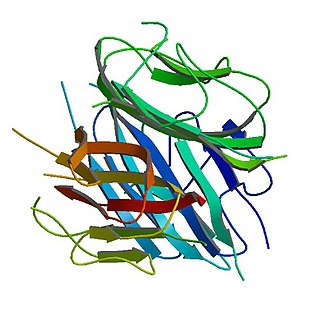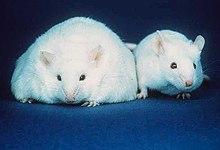
Leptin is a protein hormone predominantly made by adipose cells and its primary role is likely to regulate long-term energy balance.
Appetite is the desire to eat food items, usually due to hunger. Appealing foods can stimulate appetite even when hunger is absent, although appetite can be greatly reduced by satiety. Appetite exists in all higher life-forms, and serves to regulate adequate energy intake to maintain metabolic needs. It is regulated by a close interplay between the digestive tract, adipose tissue and the brain. Appetite has a relationship with every individual's behavior. Appetitive behaviour also known as approach behaviour, and consummatory behaviour, are the only processes that involve energy intake, whereas all other behaviours affect the release of energy. When stressed, appetite levels may increase and result in an increase of food intake. Decreased desire to eat is termed anorexia, while polyphagia is increased eating. Dysregulation of appetite contributes to anorexia nervosa, bulimia nervosa, cachexia, overeating, and binge eating disorder.

Adipose tissue, body fat, or simply fat is a loose connective tissue composed mostly of adipocytes. In addition to adipocytes, adipose tissue contains the stromal vascular fraction (SVF) of cells including preadipocytes, fibroblasts, vascular endothelial cells and a variety of immune cells such as adipose tissue macrophages. Adipose tissue is derived from preadipocytes. Its main role is to store energy in the form of lipids, although it also cushions and insulates the body. Far from being hormonally inert, adipose tissue has, in recent years, been recognized as a major endocrine organ, as it produces hormones such as leptin, estrogen, resistin, and cytokines. In obesity, adipose tissue is also implicated in the chronic release of pro-inflammatory markers known as adipokines, which are responsible for the development of metabolic syndrome, a constellation of diseases, including type 2 diabetes, cardiovascular disease and atherosclerosis. The two types of adipose tissue are white adipose tissue (WAT), which stores energy, and brown adipose tissue (BAT), which generates body heat. The formation of adipose tissue appears to be controlled in part by the adipose gene. Adipose tissue – more specifically brown adipose tissue – was first identified by the Swiss naturalist Conrad Gessner in 1551.

Adipocytes, also known as lipocytes and fat cells, are the cells that primarily compose adipose tissue, specialized in storing energy as fat. Adipocytes are derived from mesenchymal stem cells which give rise to adipocytes through adipogenesis. In cell culture, adipocyte progenitors can also form osteoblasts, myocytes and other cell types.

Adiponectin is a protein hormone and adipokine, which is involved in regulating glucose levels and fatty acid breakdown. In humans, it is encoded by the ADIPOQ gene and is produced primarily in adipose tissue, but also in muscle and even in the brain.

Agouti-signaling protein is a protein that in humans is encoded by the ASIP gene. It is responsible for the distribution of melanin pigment in mammals. Agouti interacts with the melanocortin 1 receptor to determine whether the melanocyte produces phaeomelanin, or eumelanin. This interaction is responsible for making distinct light and dark bands in the hairs of animals such as the agouti, which the gene is named after. In other species such as horses, agouti signalling is responsible for determining which parts of the body will be red or black. Mice with wildtype agouti will be grey, with each hair being partly yellow and partly black. Loss of function mutations in mice and other species cause black fur coloration, while mutations causing expression throughout the whole body in mice cause yellow fur and obesity.

Jeffrey M. Friedman is a molecular geneticist at New York City's Rockefeller University and an Investigator of the Howard Hughes Medical Institute. His discovery of the hormone leptin and its role in regulating body weight has had a major role in the area of human obesity. Friedman is a physician scientist studying the genetic mechanisms that regulate body weight. His research on various aspects of obesity received national attention in late 1994, when it was announced that he and his colleagues had isolated the mouse ob gene and its human homologue. They subsequently found that injections of the encoded protein, leptin, decreases body weight of mice by reducing food intake and increasing energy expenditure. Current research is aimed at understanding the genetic basis of obesity in human and the mechanisms by which leptin transmits its weight-reducing signal.

Fat mass and obesity-associated protein also known as alpha-ketoglutarate-dependent dioxygenase FTO is an enzyme that in humans is encoded by the FTO gene located on chromosome 16. As one homolog in the AlkB family proteins, it is the first mRNA demethylase that has been identified. Certain alleles of the FTO gene appear to be correlated with obesity in humans.
Dr. Alexander Bachmanov studied veterinary medicine at the Saint Petersburg Veterinary Institute, Russia (1977-1982), received his Ph.D. in biological sciences from the Pavlov Institute of Physiology in Saint Petersburg, Russia in 1990. He completed postdoctoral fellowships at the Physiological Laboratory at Cambridge University in 1993 and at the Monell Chemical Senses Center, Philadelphia, Pennsylvania, in the United States from 1994 to 1997. He later joined Monnell's faculty.

Mitochondrial uncoupling protein 3 is a protein that in humans is encoded by the UCP3 gene. The gene is located in chromosome (11q13.4) with an exon count of 7 and is expressed on the inner mitochondrial membrane. Uncoupling proteins transfer anions from the inner mitochondrial membrane to the outer mitochondrial membrane, thereby separating oxidative phosphorylation from synthesis of ATP, and dissipating energy stored in the mitochondrial membrane potential as heat. Uncoupling proteins also reduce generation of reactive oxygen species.

Leptin receptor, also known as LEP-R or OB-R, is a type I cytokine receptor, a protein that in humans is encoded by the LEPR gene. LEP-R functions as a receptor for the fat cell-specific hormone leptin. LEP-R has also been designated as CD295. Its location is the cell membrane, and it has extracellular, trans-membrane and intracellular sections.

Group XVI phospholipase A2 also commonly known as adipocyte phospholipase A2 (AdPLA) is an enzyme that in humans is encoded by the PLA2G16 gene. This enzyme has also been identified as PLA2G16, HRASLS3, HREV107, HREV107-3, MGC118754 or H-REV107-1 from studies on class II tumor suppression but not on its enzymatic properties. AdPLA is encoded by a 1.3 kilobase AdPLA messenger RNA and is an 18 kDa protein. It belongs to a superfamily of phospholipase A2 (PLA2) enzymes and is found primarily in adipose tissue. AdPLA regulates adipocyte lipolysis and release of fatty acids through a G-protein coupled pathway involving prostaglandin and EP3. It has also been reported to play a crucial role in the development of obesity in mouse models.
Adipose tissue is an endocrine organ that secretes numerous protein hormones, including leptin, adiponectin, and resistin. These hormones generally influence energy metabolism, which is of great interest to the understanding and treatment of type 2 diabetes and obesity.
Joseph S. Takahashi is a Japanese American neurobiologist and geneticist. Takahashi is a professor at University of Texas Southwestern Medical Center as well as an investigator at the Howard Hughes Medical Institute. Takahashi's research group discovered the genetic basis for the mammalian circadian clock in 1994 and identified the Clock gene in 1997. Takahashi was elected to the National Academy of Sciences in 2003.
Douglas L. Coleman was a scientist and professor at The Jackson Laboratory, in Bar Harbor, Maine. His work predicted that the ob gene encoded the hormone leptin, later co-discovered in 1994 by Jeffrey Friedman, Rudolph Leibel and their research teams at Rockefeller University. This work has had a major role in our understanding of the mechanisms regulating body weight and that cause of human obesity.

Teleost leptins are a family of peptide hormones found in fish (teleostei) that are orthologs of the mammalian hormone leptin. The teleost and mammalian leptins appear to have similar functions, namely, regulation of energy intake and expenditure.

Rudolph Leibel is the Christopher J. Murphy Professor of Diabetes Research, Professor of Pediatrics and Medicine at Columbia University Medical Center, and Director of the Division of Molecular Genetics in the Department of Pediatrics. He is also co-director of the Naomi Berrie Diabetes Center and executive director of the Russell and Angelica Berrie Program in Cellular Therapy, Co-director of the New York Obesity Research Center and the Columbia University Diabetes and Endocrinology Research Center.

José F. Caro is an American physician, scientist, and educator most notable for his research in obesity and diabetes. The Institute for Scientific Information listed him the third most cited investigator in the world in the field of obesity research during the 1991-2000 period for his work on Leptin. Caro is an artist and a signature member of the Pastel Society of America.
Asprosin is a protein hormone produced by mammals in tissues that stimulates the liver to release glucose into the blood stream. Asprosin is encoded by the gene FBN1 as part of the protein profibrillin and is released from the C-terminus of the latter by specific proteolysis. In the liver, asprosin activates rapid glucose release via a cyclic adenosine monophosphate (cAMP)-dependent pathway.

Pathophysiology of obesity is the study of disordered physiological processes that cause, result from, or are otherwise associated with obesity. A number of possible pathophysiological mechanisms have been identified which may contribute in the development and maintenance of obesity.













